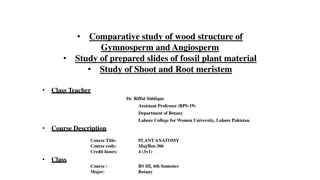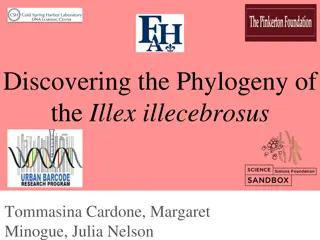Understanding Phylogeny and Evolution in Angiosperms
Phylogeny is the study of evolutionary relationships among organisms, depicted in phylogenetic trees based on shared characteristics. This overview delves into terms like homology, analogy, monophyly, and co-evolution in angiosperms with an emphasis on taxonomy, systematics, and the evolutionary history of different groups. Explore the concept of evolution and genetic changes in populations within this informative content by Dr. Habibur Rahman, Associate Professor at J. N. College, Boko.
Download Presentation

Please find below an Image/Link to download the presentation.
The content on the website is provided AS IS for your information and personal use only. It may not be sold, licensed, or shared on other websites without obtaining consent from the author. Download presentation by click this link. If you encounter any issues during the download, it is possible that the publisher has removed the file from their server.
E N D
Presentation Transcript
Phylogeny of Angiosperms Dr. Habibur Rahman Associate Professor J. N. College, Boko
What Is Phylogeny? Phylogeny is the study of relationships among different groups of organisms and their evolutionary development. Phylogeny attempts to trace the evolutionary history of all life on the planet. It is based on the phylogenetic hypothesis that all living organisms share a common ancestry. The relationships among organisms are depicted in what is known as a phylogenetic tree. Relationships are determined by shared characteristics, as indicated through the comparison of genetic and anatomical similarities.
Phylogenetic Tree A phylogenetic tree, or cladogram, is a schematic diagram used as a visual illustration of proposed evolutionary relationships among taxa. Phylogenetic trees are diagrammed based on assumptions of cladistics, or phylogenetic systematics. Cladistics is a classification system that categorizes organisms based on shared traits, or synapomorphies, as determined by genetic, anatomical, and molecular analysis. The main assumptions of cladistics are: 1. All organisms descend from a common ancestor. 2. New organisms develop when existing populations split into two groups. 3. Over time, lineages experience changes in characteristics.
Terms and concepts: primitive and advanced homology and analogy parallelism and convergence monophyly, Paraphyly and polyphyly clades origin& evolution of angiosperms; co-evolution of angiosperms and animals; methods of illustrating evolutionary relationship (phylogenetic tree, cladogram).
TAXONOMY & SYSTEMATICS Nomenclature = the naming of organisms Classification = the assignment of taxa to groups of organisms Phylogeny = Evolutionary history of a group (Evolutionary patterns & relationships among organisms) Taxonomy = Nomenclature + Classification Systematics = Taxonomy + Phylogenetics
Phylogeny-Terms Phylogeny- the evolutionary history of a group of organisms/ study of the genealogy and evolutionary history of a taxonomic group. Genealogy- study of ancestral relationships and lineages. Lineage- A continuous line of descent; a series of organisms or genes connected by ancestor/ descendent relationships. Relationships are depicted through a diagram better known a phylogram as
Evolution Changes in the genetic makeup of populations- evolution, may occur in lineages over time. Descent with modification Evolution may be recognized as a change from a pre-existing or ancestral character state (plesiomorphic) to a new character state, derived character state (apomorphy). 2 mechanisms of evolutionary change- 1. Natural selection non-random, directed by survival of the fittest and reproductive ability-through Adaptation 2. Genetic Drift- random, directed by chance events
Cladistics Classification based on phylogeny Phylogenetic systematics- Cladistics Lineage- A continuous line of descent; a series of organisms or genes connected by ancestor/descendent relationships. Relationship is depicted as phylogenetic tree/cladogram A tree-like network that expresses such ancestor-descendant relationships(Cladistic relationship ) is called a cladogram. Cladogram -Branching diagram shows the sequence of evolutionary change in characters, the number of changes associated with each lineage, and the sequence of lineage branching The branches of a cladogram represent time (unlike a phenogram).
Evolutionary tree -evolutionary relationships among taxa Phylogenies trace patterns of shared ancestry between lineages. The root of the tree represents the ancestral lineage Tips of the tree represent groups of descendants of that ancestor -descendent taxa (often species) Nodes - common ancestors of those descendants. As you move from the root to the tips, you are moving forward in time. Sister groups- species A & B are sister groups they are each other's closest relatives. An outgroup is a species or group of species that is closely related to the ingroup the various species being studied
What is clade? A clade is a group which includes a common ancestor and all the descendants (living and extinct) of that ancestor. - Members of a clade will possess common characteristics as a result of their shared evolutionary lineage - Clades can be organized into branching diagrams (cladograms) in order to show evolutionary relationships.
Phylogenetic approach A taxon (pl. taxa) is any group of organisms that is given a formal taxonomic name. Loosely, a monophyletic taxon is one that includes a group of organisms descended from a single ancestor , whereas a polyphyletic taxon is composed of unrelated organisms descended from more than one ancestor.
Phylogenetic approach A phylogenetic approach demands the taxa to be monophyletic. Monophyletic groups, including all the descendants of a common ancestor, are recognized and form entities in a classification system. Monophyletic group (clade)- a group composed of an ancestor and all its descendants. a common ancestor + all descendants of that common ancestor
Co-evolution of Angiosperms and Animals
Co-evolution refers to the evolution of at least two species, which occurs in a mutually dependent manner. Co-evolution was first described in the context of insects and flowering plants, and has since been applied to major evolutionary events, including sexual reproduction, infectious disease, and ecological communities. Co-evolution functions by reciprocal selective pressures on two or more species, analogous to an arms race in an attempt to outcompete each other.
Co-evolution Examples Predator-Prey Co-evolution: The predator-prey relationship is one of the most common examples of coevolution. In this respect, there is a selective pressure on the prey to avoid capture and thus, the predator must evolve to become more effective hunters. In this manner, predator-prey co-evolution is analogous to an evolutionary arms race and the development of specific adaptations, especially in prey species, to avoid or discourage predation.
Acacia ants and Acacias: An example of co-evolution that is not characteristic of an arms race, but one which provides a mutual benefit to both a plant species and insect is that of the acacia ants and acacia plants. In this relationship, the plant and ants have coevolved to have a symbiotic relationship in which the ants provide the plant with protection against other potentially damaging insects, as well as other plants which may compete for nutrients and sunlight. In return, the plant provides the ants with shelter and essential nutrients for the ants and their growing larvae.
Flowering Plants and Pollinators: Another example of beneficial co-evolution is the relationship between flowering plants and the respective insect and bird species that pollinate them. In this respect, flowering plants and pollinators have developed co-adaptations that allow flowers to attract pollinators, and insects and birds have developed specialized adaptations for extracting nectar and pollen from the plants.























